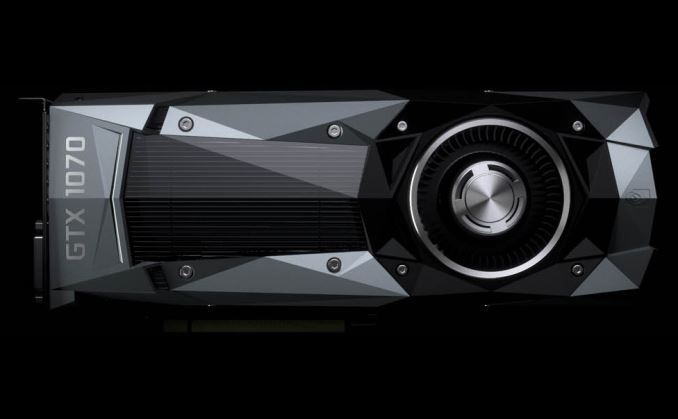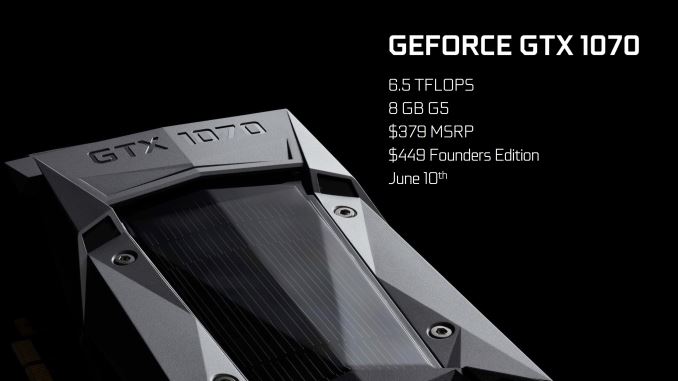NVIDIA Posts Full GeForce GTX 1070 Specifications: 1920 CUDA Cores Boosting to 1.68GHz
by Ryan Smith on May 18, 2016 10:15 PM EST
Back when NVIDIA first announced the GeForce GTX 1080 earlier this month, they also briefly announced that the GTX 1070 would be following it. The GTX 1070 would follow the GTX 1080 by two weeks, and presumably to keep attention focused on the GTX 1080 at first, NVIDIA did not initially reveal the full specifications for the card. Now with the GTX 1080 performance embargo behind them – though cards don’t go on sale for another week and a half – NVIDIA has posted the full GTX 1070 specifications over on GeForce.com.
| NVIDIA GPU Specification Comparison | ||||||
| GTX 1080 | GTX 1070 | GTX 970 | GTX 770 | |||
| CUDA Cores | 2560 | 1920 | 1664 | 1536 | ||
| Texture Units | 160 | 120 | 104 | 128 | ||
| ROPs | 64 | 64 | 56 | 32 | ||
| Core Clock | 1607MHz | 1506MHz | 1050MHz | 1046MHz | ||
| Boost Clock | 1733MHz | 1683MHz | 1178MHz | 1085MHz | ||
| TFLOPs (FMA) | 8.9 TFLOPs | 6.5 TFLOPs | 3.9 TFLOPs | 3.3 TFLOPs | ||
| Memory Clock | 10Gbps GDDR5X | 8Gbps GDDR5 | 7Gbps GDDR5 | 7Gbps GDDR5 | ||
| Memory Bus Width | 256-bit | 256-bit | 256-bit | 256-bit | ||
| VRAM | 8GB | 8GB | 4GB | 2GB | ||
| FP64 | 1/32 | 1/32 | 1/32 | 1/24 | ||
| TDP | 180W | 150W | 145W | 230W | ||
| GPU | GP104 | GP104 | GM204 | GK104 | ||
| Transistor Count | 7.2B | 7.2B | 5.2B | 3.5B | ||
| Manufacturing Process | TSMC 16nm | TSMC 16nm | TSMC 28nm | TSMC 28nm | ||
| Launch Date | 05/27/2016 | 06/10/2016 | 09/18/14 | 05/30/13 | ||
| Launch Price | MSRP: $599 Founders $699 |
MSRP: $379 Founders $449 |
$329 | $399 | ||
Previously disclosed at 6.5 TFLOPs of compute performance, we now know how NVIDIA is getting there. 15 of 20 SMs will be enabled on this part, representing 1920 CUDA cores. Clockspeeds are also slightly lower than GTX 1080, coming in at 1506MHz for the base clock and 1683MHz for the boost clock. Overall this puts GTX 1070’s rated shader/texture/geometry performance at 73% that of GTX 1080’s, and is a bit wider of a gap than it was for the comparable GTX 900 series cards.
However on the memory and ROP side of matters, the two cards will be much closer. The GTX 1070 is not shipping with any ROPs or memory controller channels disabled – GTX 970 style or otherwise – and as a result it retains GP104’s full 64 ROP backend. Overall memory bandwidth is 20% lower, however, as the GDDR5X of GTX 1080 has been replaced with standard GDDR5. Interestingly though, NVIDIA is using 8Gbps GDDR5 here, a first for any video card. This does keep the gap lower than it otherwise would have been had they used more common memory speeds (e.g. 7Gbps) so it will be interesting to see how well 8Gbps GDDR5 can keep up with the cut-down GTX 1070. 64 ROPs may find it hard to be fed, but there will also be less pressure being put on the memory subsystem by the SMs.
Meanwhile as is usually the case for x70 cards, GTX 1070 will have a lower power draw than its fully enabled sibling, with a shipping TDP of 150W. Notably, the difference between the GTX 1080 and GTX 1070 is larger than it was for the 900 series – where it was 20W – so we’re going to have to see if GTX 1070 ends up being TDP limited more often than GTX 1080 is. In that sense TDP is somewhat arbitrary – its purpose is to set a maximum power consumption for cooling and power delivery purposes – and I’m not surprised that NVIDIA wants to stay at 150W or less for the x70 series after the success that was the GTX 970.
Like the GTX 1080, the GTX 1070 will be launching in two configurations. The base configuration is starts at $379 and will feature (semi) custom partner designs. Meanwhile as previously disclosed, NVIDIA will be offering a Founders Edition version of this card as well. The Founders Edition card will be priced at $449 – a $70 premium – and will be available on day one, whereas this is not guaranteed to be the case for custom cards.
The GTX 1070 Founders Edition card will retain the basic stylings of the GTX 1080, including NVIDIA’s new angular shroud. However I have received confirmation that as this is a lower TDP card, it will not get the GTX 1080’s vapor chamber cooler. Instead it will use an integrated heatpipe cooler similar to what the reference GTX 980 used.











137 Comments
View All Comments
rocky12345 - Friday, May 20, 2016 - link
I most likely will be able to sell the pair of 390x cards for a nice price still considering they are selling retail for $499.99 - $629.99 Canadian at Mem Express. So I am not worried about selling them & not having enough money to get either the 1080 or the 1070 cards. My cards were bought in the fall of 2015.webdoctors - Thursday, May 19, 2016 - link
Its funny how ppl are complaining about price, but AMD paper launched a $1500 card on anandtech last month:http://anandtech.com/show/10279/amd-releases-radeo...
Where's the outrage there?
I'm one of those mainstream $200 market folks, and the deals there are amazing now (GTX970 for ~$225 now!). Those drops wouldn't have happened without this product. Lets wait for the Anandtech table that shows what's the best card to buy in each $ category this summer.
JamieK - Thursday, May 19, 2016 - link
That is a HPC card. Priced accordingly.vladx - Thursday, May 19, 2016 - link
It's not a HPC card like a Tesla or Firepro. Just a dual Fji, price giouging is very accurate here since it's a lot more expensive than two Fiji.RussianSensation - Thursday, May 19, 2016 - link
Nobody cares about the Radeon Pro Duo in the mainstream market. This is a Pro card with FirePro certified drivers too and is made for VR development. They could have priced it at $5,000 US. Otoh, most of us do care about the $300-700 market. Anyone comparing Radeon Pro Duo to the price increases NV implemented since $249 GTX560Ti -> $499 GTX680 -> $549 980 -> $599-699 1080 is grasping at straws. GTX1070 is also the most cut down x70/x75 series card ever made, and NV jacked up the price from $329 970 to $379-449 for the 1070 while separating them in performance by 20-30%.vladx - Thursday, May 19, 2016 - link
Doesn't matter, this is price gouging at it's finest since the only difference are the drivers.xthetenth - Friday, May 20, 2016 - link
At least the drivers have the excuse of being a long-standing form of market stratification and much more importantly having major QA costs for a generally niche market.abrowne1993 - Thursday, May 19, 2016 - link
So how will this likely stack up compared to the 980 Ti?joex4444 - Thursday, May 19, 2016 - link
6.5TFLOP vs 6.0TFLOP, it should be about the same. Thing is you'd need a stock 980Ti to compare it to, and most 980Ti cards actually come with a 10-20% OC so I'd expect the 980Ti to still win. Better value depends on what the prices for 980Ti settle to and how important power consumption is to the buyer.TallestJon96 - Thursday, May 19, 2016 - link
NVIDIA definitely seems to be pulling the x70 series back some. If I remember correctly, the gtx 970 outsold the 980 by about 3:1 (steam hardware survey). the 1070 is definitely less impressive relative to the 1080 than the 970 was compared to the 980. Some numbers for you based on hardware (not performance or FPS)970 vs 980:
80% cuda cores
97% clock speed
100% memory bandwidth
For 60% of the cost
1070 vs 1080:
75% Cuda cores
97% clock speed
80% memory bandwidth
For 63% of the cost
If you analyze cost per cuda core, relative to the higher end chip, the 970 had 133% of the value of the 980 while the 1070 is only 119% of the value of the 1080. Basing it on memory bandwidth changes those numbers to 166% for the 970 and 127% for the 1070.
On top of the performance and price difference, NVIDIA is holding the 1070 back 2 weeks, and is not giving it any press.
I own a 970 and upgraded to 1440p/144hz so I'm just debating between the two cards. 970 was the clear winner last time, but it's a tough call now.